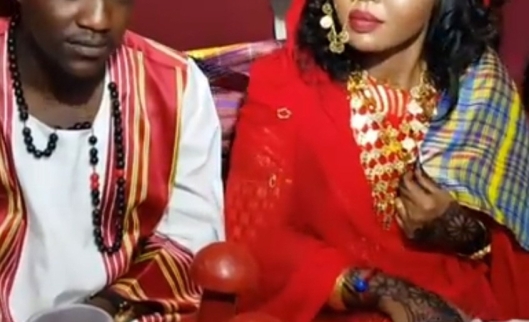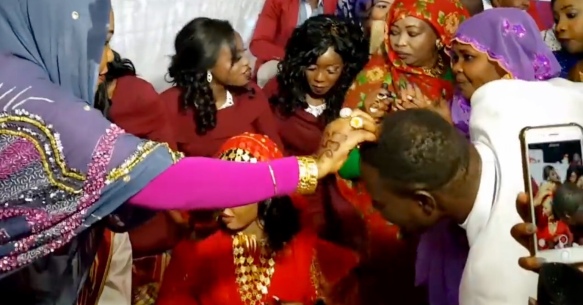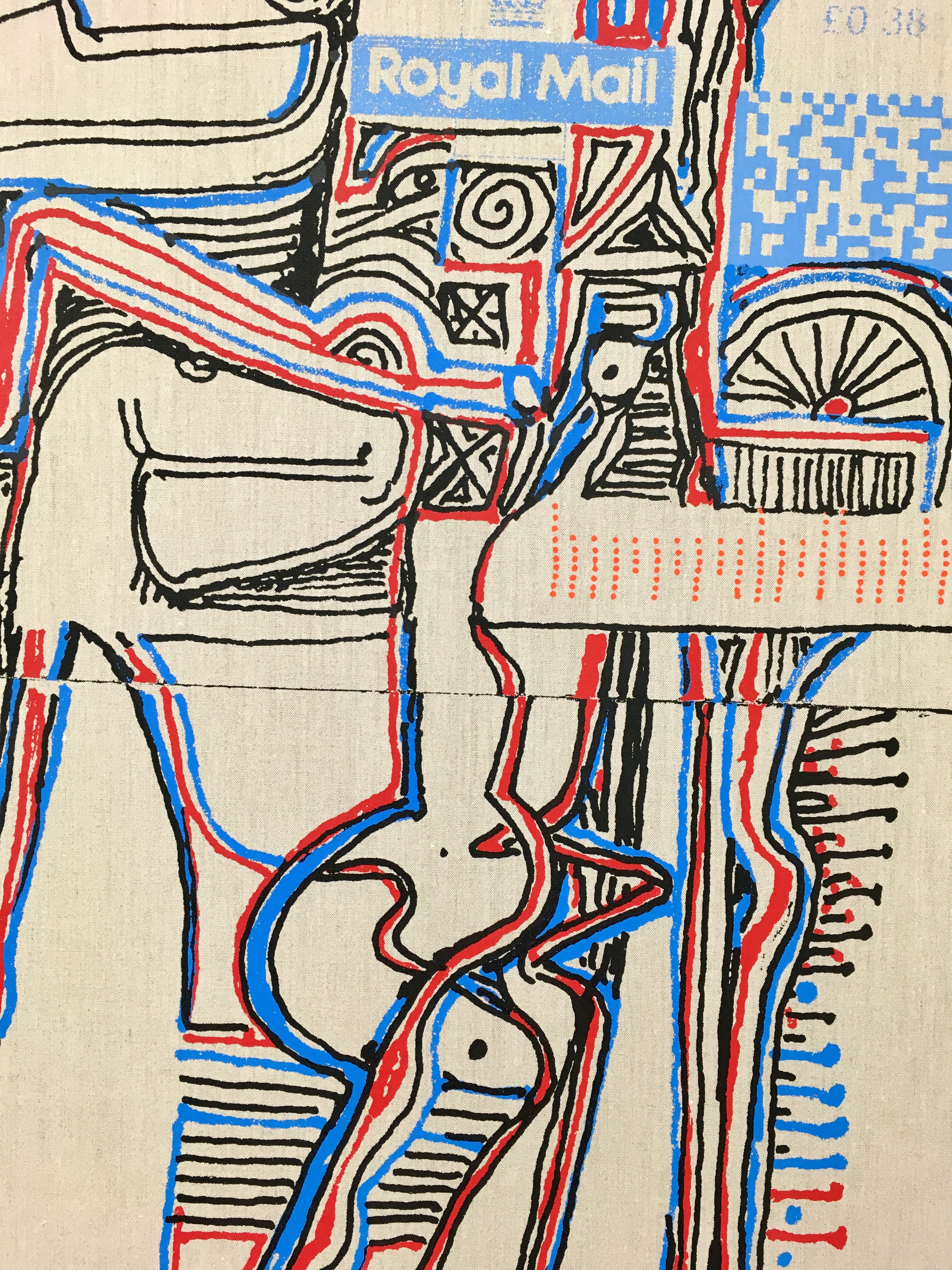Anointing in Robes of Red and Gold

Setting the Scene – Anointing, Robes of Red and Gold; The Drama and Symbolism of Jirtig Rituals; An 1940’s Account of Wedding Jirtig Rites

Setting the Scene – Anointing
He is your King, he is Master of Kush, who will safeguard you / He is the Son of Ra, blessed, his Father was Ra. He is your Lord – Coronation Stela

Queen Amanishakheto, the Warrior Queen of Nubia – photo Wikicommons
Ancient Kerma and Meroitic coronation rituals are believed to be at the heart of the Jirtig rite of passage rituals unique to the riverain tribes of northern Sudan. They are rites officiated by women and in which women play dominant roles.

Bride and groom being anointed with scented oils and powders
“Drums are heard, incense smelled. The high priest goes out from the holy room and stands behind the king, who is kneeling. Puts his hand on his head. A number of priests enter, carrying an incense burner. They are blessing, dancing and reciting.”
Ritual Coronation Scenario of King Aspelta , Rituals and Ceremonies in Sudan From Cultural Heritage to Theatre, Mieke Kolk (Editor)

In traditional wedding Jirtig rituals, bride and groom would sit side by side on the bed or ‘angarib, while trusted female relatives invested them with sacred objects and anointed them with scented oils – echoing, it is claimed, ancient Meroitic coronation rites
See Jartig, A Feature of an Ongoing Civilization

An ornate tagiya (prayer cap) is placed on the bridegroom’s head, above the red band bearing a silver or gold crescent (hafiza). The headband is said to evoke the crown, bearing gold and feathers, of meriotic kings
All Jirtig Screenshots from Youtube’s Best Sydney Sudanese Wedding
Among the many theories explaining the origin of the word Jirtig is that of Dr. Ahmad Moutism Al Shiekh, below:


Setting the Scene – Robes of Red and Gold

An Omdurman bride swathed in her traditional red and gold embroidered “toub al Jirtig”. Blood red and precious gold, both propitious and talismanic in rites of passage.
This is a cultural blogpost for Women’s Education Partnership

Interested in learning more about us? Visit Women’s Education Partnership

Learn more about our scale and reach in At a Glance
Please consider giving to our life-changing work. Just click on the link below to donate quickly and securely:
Critical discussion of wedding and marriage customs, including the Jirtig, plays a central role in our development through literacy programs

The bridegroom prepares to spray wedding guests with perfume. He wears the traditional red and yellow-gold trimmed wedding robes, known as toub surrati that some claim evoke Meriotic coronation robes. Round his neck hangs a long wedding rosary or sibHa yusr of black wood and red coral prayer beads. Traditionally these beads were soaked in milk and zirria – the water of soaked and sprouting dura grains – symbols of fertility.

Jirtig robes – illustrations from Griselda El Tayib’s Regional Folks Costumes of the Sudan. Scroll down to read more about the book

The bride, lifting her “garmasis” veil, whose iridescent sheen was believed to protect against jealous spirits. Originally imported from India, the garmasis is associated with rites of passage for both men and women – worn by mothers after childbirth and during the following forty days of confinement and by young boys at their circumcision. Traditionally, the bride would appear to the groom “entirely wrapped in the garmasis like a mysterious parcel when she is brought in first to the dancing arena….” Griselda El Tayib’s Regional Folk Customs of the Sudan, p 122

Bride and groom wrapped in the garmasis during the jirtig ceremony of a modern Sudanese wedding.
Screenshot from Youtube’s Best Sydney Sudanese Wedding
The groom, below, holding a folded garmasis while his bride dances. Around her waist, the bride wears the al hagu – a string of beads traditionally made of imitation coral and silver balls which act as tiny rattles. The bridal dance can both precede or follow Jirtig rituals.

See rare public footage of the bridal dance at the end of this post
Griselda El Tayib’s latest work, below, showing in the foreground a young bride wearing the traditional dancing dress and gold coin-studded cap of black netted silk known as mashabak or tagiya, woven into the hair with needle and thread. Al Tayib’s work documents changes in wedding attire and customs from 1930’s to the present day.

Scroll down to watch a Sudanese documentary (English subtitles) on this remarkable Anglo-Sudanese artist, illustrator and expert on the cultural significance of costume

See coming posts on Sudanese bridal jewelry photo Pinterest

Wedding Perfumes and Oils Shop, central Khartoum

Anointing in Red and Gold – The Jirtig, Drama and Symbolism, A 1940’s Account – Marriage Customs in Omdurman
The Jirtig; Drama and Symbolism – Milk and Incense

Photograph Michael Freeman, Sudanese Woman in Omdurman Market, showing shop door mural of a wooden huqq jar, used for storing perfumed and oil-infused pastes and powders. Vessels similar to huqq have been unearthed in Kerma burial sites.
“no you may not come inside the house/ to fetch away your bride/ from her one girlhood home/ yet / first you must dip your hands / into the lovely bowl / of pure white milk” Nor be with you, Arif Gamal, Morning in Serra Mattu

Milk on the Jirtig tray – ancient symbol of fertility and prosperity in marriage and used in coronation and investiture rites of Nubian monarchs
This is a cultural blogpost for Women’s Education Partnership

Interested in learning more about us? Visit Women’s Education Partnership
Please consider giving to our life-changing work. Just click on the link below to donate quickly and securely:
Some Theories
Jirtig invests the young man embarking on the rites of passage such as circumcision and marriage with the authority and divinely ordained protection of kingship. Sword, whip and kingly robes consecrate and shield the initiate on his journey into manhood and marriage. In the past, separate Jirtig ceremonies were conducted for the bridegroom, officiated by his senior female relatives.

“Seated on an Angaraib decorated with arched palm fronds, he is anointed with oil and khumrah. Then he gets up with a sword hanging in its leather scabbard from his shoulder, a hippopotamus hide whip in his right hand …” Read more here Abdulla El Tayeb – The Groom‘s Jirtig in Changing Customs of the Sudan and a 1922 Sudan Notes and Records account of the bridegroom’s Jirtig in Wedding Customs in the Northern Sudan

Beja wedding sword – photo kindly provided by Alan Johnston Sudan Teachers FB Group

Shielding both bride and groom from malevolent and envious spirits as well as invoking propitious omens, the use of incense, anointing oils, and talismans such as scarab beetles and fishbones ward off misfortune and invoke fertility and plenty. The recurrence of the number seven is also laden with sacred, protective powers – milk is sipped seven times, handfuls of grain and dates are exchanged seven times and the bridal Jirtig was traditionally held on the evening of the seventh day of the wedding celebrations.
Boys donning robes and perfumes traditionally reserved for females during their circumcision jertig rituals may, some researchers suggest, be a means of deflecting the evil eye.

Wedding dance, Singa, 1984-87. Photo Kindly provided by Alan Johnston, Sudan Teachers Facebook Group
![]()
Sudanese proverb, literally “extension of Jirtig”, used to describe a person or thing whose presence is irrelevant or of no use. As the Jirtig rituals, with all their theatrical vibrancy, are complete of themselves, any additions made by the family add little to their impact. My thanks to Muna Zaki Proverbs and Folktales for this proverb

Sophie Zenkovsky’s 1940’s Marriage Customs in Omdurman
Below is an edited version of her account of Jirtig rituals among the Ja’aliyyin and Mahas tribes people settled in Omdurman. Read the full text here: Marriage Customs in Omdurman

Advertisement for special Jirtig biscuits, in the shape of perfume huqqs and wedding rosaries and right, wedding invitations
The bride and groom sit side by side facing East while in front of them are seated the officiating women…… The bridegroom dressed in a white tob surrati, is seated on the right side of the bride, who is wrapped in her firka (garmasis-type veil). The women seated in front of them are specially selected for the honor. As soon as they all have taken their places, two dishes of oil with wadaq and scent making a liquid (dihn) called karkaar are brought from the kitchen, a big dish for the bridegroom and a small one for the bride, and put on their respective tables.

The Jirtig tray, laden with perfumes oils, pastes and incense
Each woman takes the hands of the person in front of her, plunges them in the liquid, and puts them on his or her head. This is repeated twice. After this comes the dressing of the heads. White dihn is smeared thickly all over the head, a cloth is put round the forehead so as to make a good round ridge, dry spices /sandal and mahlab) are plastered on the dihn making a pinkish cap, scent is sprinkled on it and on the audience, who rend the air with joy-cries, songs and the clapping of hands. The cloth round the forehead is then removed, the face cleaned and an ornament shaped like a crescent moon on a string of red or blue material is hang on the brow of the bridegroom

Anointing the heads of wedding guests with dariirah – milled sandalwood soaked in perfumed oil
Now comes the putting on of the the Jirtig, the crux of this ceremony. The Jirtig is a bunch of reddish -purple silk threads with a tassel dependent from it. On the silk are threaded the following always in the same order :- a very large green bead, a fish vertebra, a small white bead, and a medium-sized, pale green bead (suluk)

The bride holds out her arm while a skein of magenta silk threaded with blue or green stones, also known as the hariira or Jirtig, is tied to her wrist. The groom will also be given a Jirtig. Traditionally the stones uses were agate, amber or coral.

Jirtig bracelet with blue stones and fish bone – a symbol of fertility
It is worn by the man for nine days – a week is considered enough for government employees – and by the woman for a month. The dressing is now finished and the girl guests help themselves to the dihn and scent left over. A glass of milk is given to the bridegroom, he takes a mouthful and, turning to the bride, sprays her with it.
See coming posts on Sudanese perfumes

The bride, who has uncovered for the performance, dives under her toub but the bridegroom takes another sip and tries to get the bride unawares under her toub to spray her face. This is repeated twice.

Spraying with water, instead of milk
They both then cup their hands into which grain, dates and coins are poured and which they exchange seven times.

After this, the bride returns to her room, and the bridegroom and the girls prepare themselves for the procession(saira). Lamps are lit, and the bridegroom, armed with his hippo-hide whip, and sword …….
This is a cultural blogpost for Women’s Education Partnership

Interested in learning more about us? Visit Women’s Education Partnership

See also Changing Times:Sudan’s wedding traditions in flux
The Jirtig: A Belief as old as History
Jartig A Feature of an Ongoing Civilization
Sisters Under the Sun, The Story of Sudanese Women Marjorie Hall and Bakhita Amin Esmail, 1981, p 169
Anne Cloudsley’s Women of Omdurman 1983, pp 56/7 which draws on Zenovsky’s account
Abdulla El Tayib Changing Customs of the Sudan, 1955 description of Jirtig male circumcision rituals, p 75


Sudanese Wedding Dance
Griselda El Tayeb documentary (English subtitles)


So many memories of living in Khartoum 1976-1981. working at UNHCR for refugees coming g to the Sudan. Loved listening to your documentary Griselda. Maybe our paths crossed while I was living there.
LikeLike
Thank you so much for getting in touch – and what interesting work you must have been doing. I was based in Northern Province(Dongola) 1984-1989 as an contract English teacher for the Ministry of Education. I have never returned there – one day! But I do visit our literacy project in Khartoum every year – it’s also changed so much since the 80’s but the Sudanese are as wonderful as ever.
Thank you for taking the time to read the blog!
LikeLike
my grandaughter is running marathon in Cambodia next month. I’m wondering if you have a website for giving to the women’s literacy in case she wants to set up a justgiving to raise funds.
Also I would love to own a copy of Griselda’s book but cannot find it on Amazon. Do you know where I could find a copy or perhaps Griselda is in the uk or I could have her contact email.
Lovely reading about your experiences in Sudan. Looking at those wonderful photos brought it all those happy memories. My Sudanese colleagues and especially the women were wonderful.
Thank you for sharing with me.
LikeLike
Hi Elizabeth and lovely to hear from you. I got Griselda’s book from Amazon but I do know a friend of hers who might be able to put you in contact with her. I’ll write to him, a professor of Nubian languages. My blog posts and pages cover many aspects of literacy training following a methodology called REFLECT. Your daughter can find many online resources for this.
https://www.participatorymethods.org/resource/reflect-mother-manual-regenerated-freirean-literacy-through-empowering-community-techniques
This site gives lots of resources, including the mother manual. I am very happy to help your granddaughter in any way at all if she would like to get in touch. My email is iethurbon@yahoo.co.uk
LikeLike
Please forgive me – I misread your very kind comment. If your granddaughter might be interested in raising funds for literacy, our website with donations page is http://www.womenseducationpartnership.org/
LikeLike
Great information! Where can one buy a family’s perfume commercially? What about blk henna with authentic Sudanese designs near Washington DC Metro area any? any groups/ areas/ stores
LikeLike
Mary, thank you so much for your comment. Perhaps other readers might be able to advise. I’m so sorry but I don’t know the answer. I go to Sudan once a year – sadly not these last two years because of the pandemic, so buy a little perfume there.
LikeLike